From eating with the seasons to enjoying an aperitivo, from devouring a pizza in Naples to grazing the street markets of Palermo, and whether hunting for truffles or the best possible gelato, Italy boasts an abundance of ways to experience one of the world’s most beloved cuisines.
We’re celebrating the arrival of our newest book, Rick Steves Italy for Food Lovers — available now. During the pandemic, I worked closely with Rick and co-author Fred Plotkin to assemble this comprehensive handbook for the traveler — teaching visitors how to fully experience the joys of eating and drinking in Italy, and to think about food the way Italians do. And now that the book is finally out, I’ve been dreaming about the many wonderful food experiences I’ve savored all across Italy. Here’s my selection of 10 amazing Italian food experiences — which, I hope, will inspire you as you plan your own travels.
Of course, this is just one traveler’s list. What are some of your favorite Italy food experiences? Share yours in the Comments.
Eating Local: Culinary Campanilismo
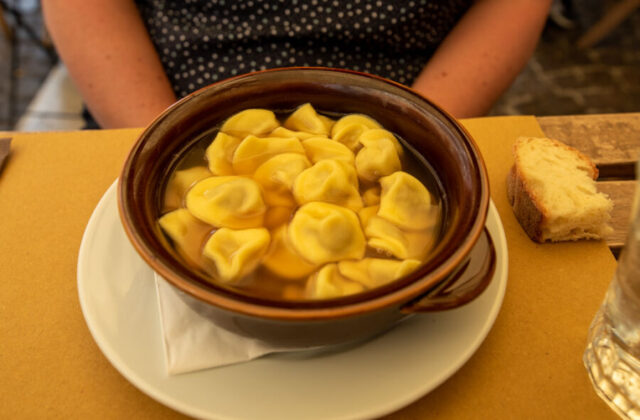
Recently I posted about some of the excellent foods I’ve had in Emilia-Romagna — including a bowl of what I identified as tortellini in brodo. In the Comments, a stickler called me out: “Sorry for you but these aren’t tortellini.” So I looked it up. And, sure enough, Parma (where I enjoyed this dish) has its own version of tortellini, which the parmigiani call anolini. If you lined up 100 non-Italians, at least 99 of them would be hard-pressed to explain the difference between tortellini and anolini. Does it really matter?
Yes, it does. And I was wrong.
Campanilismo is the fierce loyalty Italians feel to their immediate community… literally, the people who live within earshot of the same bell tower (campanile). And Italian cooking, too, is exactingly local.
As my wife and I explored Piedmont last September, we were struck by how similar menus were from place to place. Each dish was a piemontese specialty we’d rarely seen elsewhere. Tajarin (skinny, vivid-yellow, egg-yolk noodles) were smothered in a variety of sauces. When it comes to Castelmango cheese, with a decadent texture and a wipe-a-tear pungency, a little goes a long way. And several meals ended with bonèt, similar to a chocolate flan.
We used “eating local” as an excuse to stretch our culinary boundaries. Normally, we’d give a pass to vitello tonnato — veal with a creamy tuna-caper sauce — based on the description alone. But knowing it was a local forté, we tried two very different versions. And both were excellent.

It’s not just regions. These localized specialties often come down to the town…or even the neighborhood. In Rome’s historic Jewish Quarter, signs advertise carciofi alla giudìa — “Jewish-style” artichokes. Taking the hint, I ordered an item that looked like some crispy-crunchy alien appendage. And it was a memorable, and delicious, treat.
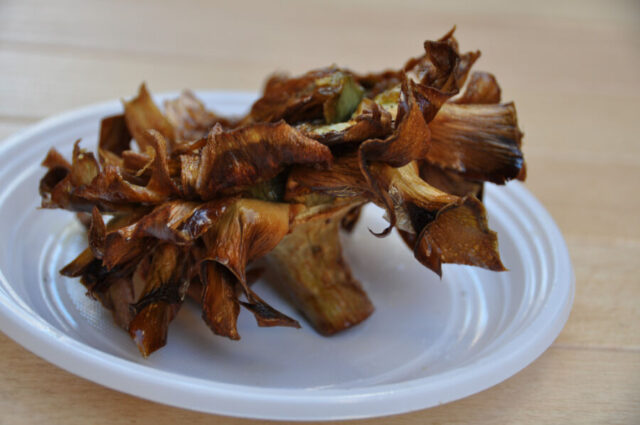
Don’t head to Italy with a “bucket list” of foods that you’ll demand to eat while there. Instead, let the locals tell you what they are excited to feed you
Eating with the Seasons
Italians brag that if you show them a menu from any restaurant in Italy, they can identify not only where it comes from…but what time of year. That’s because the best food is not only local — it’s highly seasonal.
Speaking of artichokes, I happened to be in Rome last March, when artichokes were absolutely everywhere: piled in neat pyramids in grocery store windows, on restaurant menus, and so on. Walking through the Testaccio Market, I saw piles upon piles of those beautiful vegetables, with their artful ombré of green and purple. It felt like the city was having one big artichoke party.

Italians know the rotating calendar of seasonal specialties, and they track those annual cycles with a special verve. On a springtime visit to Palermo’s street markets, a flurry of activity engulfed a table displaying gigantic slabs of bright-pink tuna, just caught. The fishmongers set out little sprigs of delicate spring mint, symbolizing that tuna season had begun. During the brief window when the tuna is this fresh, you eat it virtually rare — barely kissed by flame, then onto your plate.
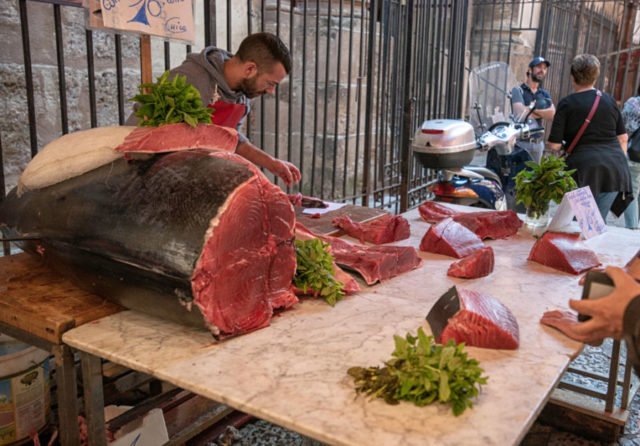
One fall in Tuscany, the hillsides were mostly bare except for the neon-green fuzz of winter wheat. Trees were naked; bushes were brown. But on a few spindly branches dangled plump orange fruits: persimmons. One of the best dishes I had on that trip was a dessert consisting of chestnut mousse with persimmon purée. It tasted like a Tuscan autumn.
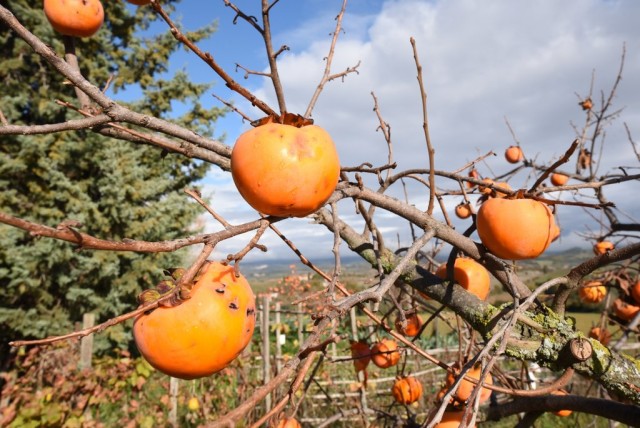
One dish my wife and I did not have on that trip to Piedmont? Truffles. Even though it’s a truffle-crazy region, we were just a dozen days or so too early to enjoy that delicacy in its prime. And so, it was notably absent from local menus.
We Americans are used to getting what we want, when we want it. But when we do that, we sacrifice quality. Recently, at my local supermarket, I bought some tomatoes and strawberries. And, because it’s winter, they tasted almost indistinguishable.
Italians have patience. They know good things are worth waiting for. And when you have an ingredient or a dish just once a year, its flavor is that much more special.
Indulging in Passeggiata, Aperitivo, and Apericena

When visiting Italy, let yourself get swept up in the passeggiata — that special hour or so each evening when the entire community does lazy laps around the city center. And as you stroll, don’t miss a parallel custom happening along the fringes of that street: the aperitivo, an after-work, pre-dinner drink enjoyed among friends. People meet up to have a cocktail, socialize, take a little break from their evening constitutional…and enjoy their beautiful cityscape.
At aperitivo time, Italians people-watch from café tables, or stand around in little clusters, engrossed in conversation. In every hand is a bright-orange glass of Aperol spritz. It’s all so…civilized.

Some bars throw in a small snack — a basket of potato chips, or a little bowl of nuts. Others lay out a delectable antipasti spread to lure in passersby. For the cost of a cocktail, you can fill up a small plate with munchies. Places with especially substantial snacks sometimes call this apericena — a pun combining aperitivo and cena (dinner). And, while it’s bad form to take this too literally and assemble a full dinner from the buffet, if you’ve had a big lunch, the snacks that come with a couple of drinks may tide you over until morning.
Cooking with the Locals
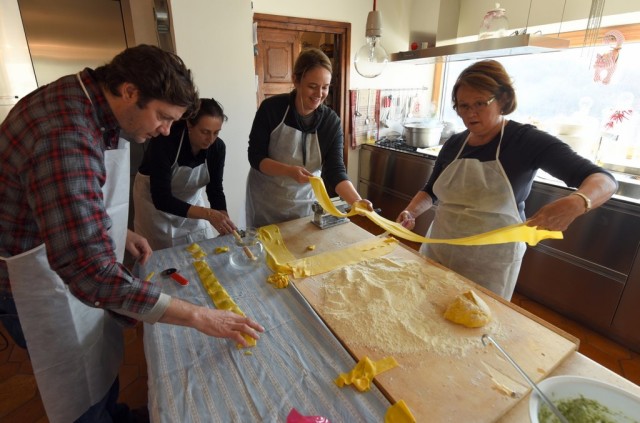
Taking a cooking class is a wonderful way to connect with Italian food culture, and to pick up a new skill. But a “cooking class” can take many different forms.
On a mist-enshrouded hilltop, a Michelin-starred chef invited visitors into his kitchen for an unforgettable lesson in olive oil, risotto, roasting meats, and, of course, making pasta. He began by rolling out sheets of pasta, then attacked each one with his knife to instantly trim it into textbook specimens of different noodles: “Papardelle,” he said, chopping thick ribbons. “Tagliatelle” — this one was thinner. “Capellini.” Thinner still. With each batch, he grabbed the wad of newborn noodles and tossed them gently in the air.
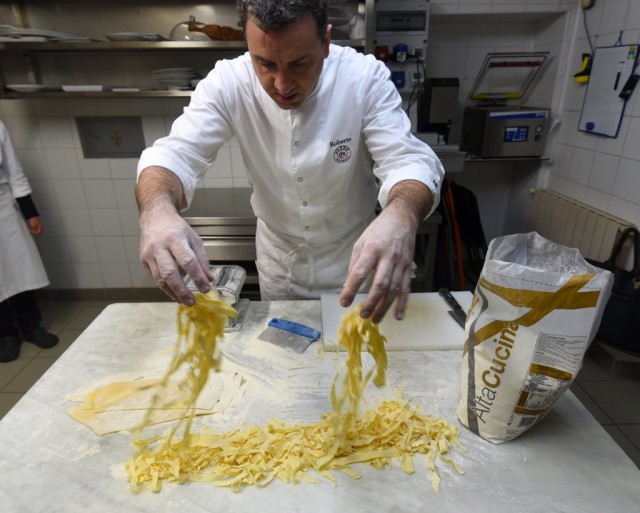
On a nearby hillside, Mamma Laura masterfully orchestrated a meal for her eager students. She’d demonstrate the task at hand — chopping up chunks of squash, packing ingredients into little pouches of cabbage, rolling out long sheets of pasta dough — then turned us loose to try it out. Ingredients would disappear into an oven or pot or blender, then reappear when it was time for the next step. Miraculously, everything was finished at exactly the right time. And it was all delicious.
At a rustic country hotel, every Thursday night is pasta-making night: All of the guests gather on the veranda, and Isabella walks everyone through how to make the local, hand-rolled pici noodles — from a little “volcano” of flour with raw eggs in the caldera to a delicious feast. Everyone gets in on the action: Grandparents and little ones all challenge each other to roll out the perfect noodle.
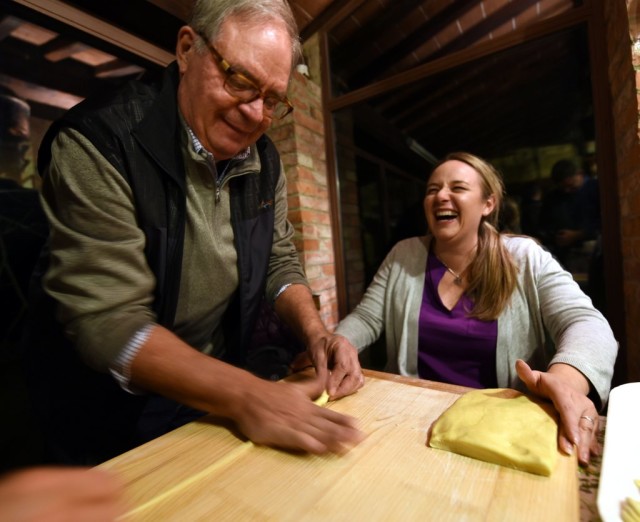
Because Italian chefs are more impressed by top-quality ingredients than by complicated technique, many dishes are relatively easy for beginners to replicate at home. (The hardest part can be finding those premium ingredients; once you do, the cooking is a snap.) One of the mainstays in my family’s menu planning is an outrageously delicious tomato sauce we learned from a restauranteur named Marta. It requires just a few ingredients: tomatoes, garlic, olive oil, salt, pepper, and — if you like a little kick — red pepper flakes. Each time we make it, it transports us back to some of our favorite travels. (Pssst! You can find the recipe here.)
Browsing a Palermo Street Market
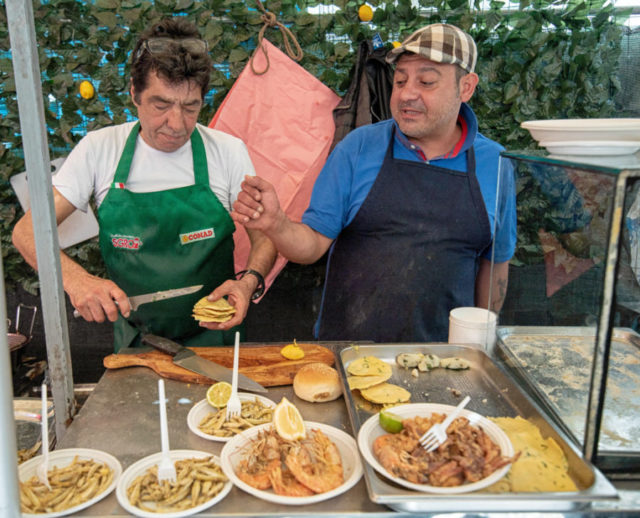
Spleen sandwich? Fried-up leftovers of veal cartilage and organs? An entire tiny octopus, boiled to tender perfection in inky water?
Say what you will about these dishes…there’s no doubt they’re some of the most memorable things I’ve eaten in Italy. And I ate them all within a few hundred yards of each other, in the street markets of Palermo.
Palermo’s three sprawling street markets — Ballarò, Capo, and Vucciria — let you delve into gritty Sicilian culture. Joining a food tour (I did one with Marco from Streaty) makes the experience far more accessible, ensuring that no weird food goes untasted.
Many items here are delicious by any standard: arancina, a deep-fried ball of saffron rice and meat sauce; sfincioni, French-bread-style “Sicilian pizza,” grilled up to order; and, of course, cannoli, a crispy pastry tube that’s filled to order with luxurious ricotta.

Others put you precipitously steep on the street-food learning curve: frittula — basically the leftover parts of veal (cartilage, intestines, little bits of bone) all chopped up, griddled, and seasoned with generous salt and lemon juice; or pani ca’ meusa — a pillowy bun stuffed with spleen, lung, and other organ meat. These bites challenged my ethic of always being willing to try a local dish…once.
The best tours also teach you how to think about the market like a Sicilian. Marco prodded us to hear the echoes of Sicily’s historic connections to North Africa in the melodic sales pitches of today’s vendors, and challenged us to view vendors with slippery pricing through a lens of good-natured gamesmanship.
Best of all, the whole time you’re browsing these gut-bombs, you’re fully immersed in the energetic hubbub of Sicilian urban life — watching the palermitani greet old friends, listening to the urgent musicality of those vendors’ patter, and smelling all that sizzling and frying goodness (plus a full spectrum of other odors).
Slamming Down un Caffè While Standing at a Counter

The Italian stand-up coffee counter has a special allure. Both efficient and social, this experience comes with a practiced ritual: First, you tell the cashier what you want, and you pay. They hand you a little slip of paper that you take over to the counter, where you get the barista’s attention. Once the drink is prepared, you stand there just long enough to down it. Maybe you make conversation with your fellow patrons or the staff. And then, within a matter of minutes (maybe less)…you bid everyone a cherry Ciao, grazie! and head on your way.
This is just what the doctor ordered when you’re fresh off the plane — disoriented and jet-lagged — to jump-start that wonderful feeling of “Hey! I’m in Italy!” The experience delightfully bombards all your senses: The smell of fresh-ground coffee as you walk through the door. The sound of the hissing steamer and the glockenspeil-like clink-clink-clink of teensy spoons against teensier ceramic cups. The mesmerizing, machinelike efficiency of the baristas’ practiced motions, a conveyer belt of full and empty cups, doing their perpetual loop from espresso machine to counter to dishwasher. And, of course…the coffee itself.
This ritual is also highly satisfying at breakfast time. Last year, I made a point to skip out on my hotel’s paltry buffet to enjoy stand-up breakfasts among the Italians in Siena, Rome, Trieste, and many other places. There’s something joyful about standing still and getting caffeinated while you watch the town wake up. Instead of strolling tourists, the narrow streets are filled with delivery people pushing hand trucks.
And often, there’s a special local pastry to try. One morning in Rome, I noticed everyone was ordering the local version of a “breakfast of champions”: A cappuccino and a maritozzo (puffy brioche roll filled with whipped cream). I would never be able to stomach this sugar-bomb back home…but in Rome, it just felt right.
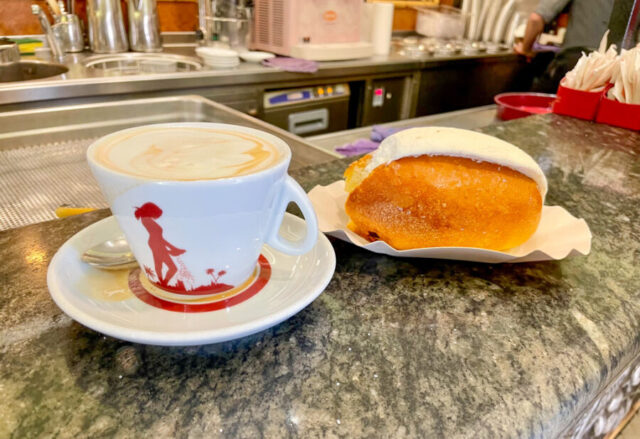
Eating Pizza in Naples
Even when a food is available worldwide — maybe especially in those cases — it’s a rare treat to have it in its birthplace. The first time I went to Naples, I was skeptical that the pizza would really be all that different than the myriad versions I can get in my foodie hometown. Rarely have I been so wrong! In Naples, even a basic pizza is a revelation.

I met up with a Neapolitan friend, Vincenzo, who couldn’t wait to take me to his idea of the best pizzeria in town. Choice of toppings? Psssh. Here you have just two options: marinara or Margherita. Like In-N-Out Burger back home, this pizzaiolo understands that when you achieve perfection, you keep things simple.
When the pizza hit our table, Vincenzo took a bite and rocketed into performative ecstasy. “Aha! You taste that? The perfect crust. Thin, soft, a leetle sour. You don’t even need to chew it. You just put it in your mouth and…” He pantomimed a delicious glob of pizza sliding down his esophagus, ending with a big smile.

Watching me gingerly nibble at my slice, Vincenzo said, “This is the correct way to eat pizza.” He cut out a wedge, rolled it up into a bundle, sawed off a crosswise chunk, and jammed it into his mouth. I tried it. And in one perfect bite, I got the gooey middle, the singed crust, and a squirt of tomato sauce — all in just the right proportions.
Neapolitans, you see, are pizza perfectionists. And after spending some time there, you’ll be in danger of becoming a pizza snob, too.
Hunting for Truffles (and Other Food Experiences)

Some of the most vivid food experiences in Italy don’t even involve eating — but rather, learning about where your food comes from. This can be a tour of a facility that produces Parmigiano-Reggiano or pecorino cheese; a walk through vineyards and wine-production facilities; or a trip to the community olive press. Or it can involve walking through the woods.
One chilly November morning in the hills of Tuscany, I met a professional truffle-hunter, Paolo, and his trusty assistant, Milli. Milli — who, it seems pertinent to note here, is a dog — skittered off into the underbrush, nose twitching, tail wagging, in hot pursuit of those mysterious deposits that hide a few inches underground.
As we chased after her, Paolo explained that you can’t actually “plant” truffes — all you can do is cultivate the land to create an ideal habitat, scatter a few spores…and hope. And then, when they truffles begin to release their unmistakable aroma, Milli does the rest. Paolo began training her when she was just 10 days old — feeding her tiny bits of truffles to develop her palate. Teaching her how to find the truffles was the easy part, he said. The hard part was getting her to stop eating them.
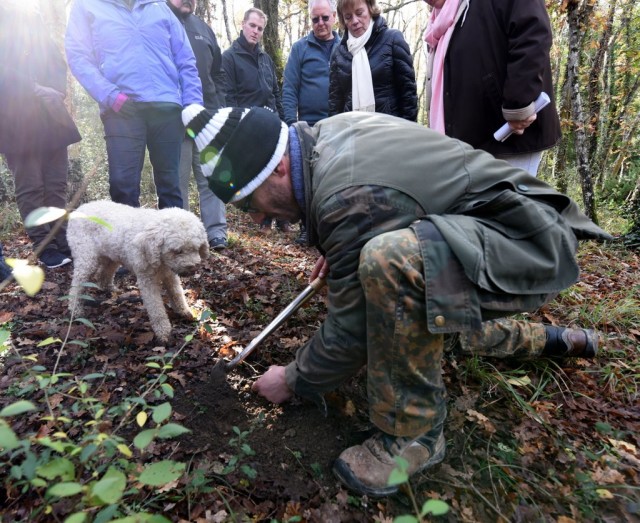
As if on cue, Milli began excitedly pawing a particular spot in the ground. Paolo rushed over, held her back, and used his special shovel, with a surgeon’s precision, to extract the nugget from the damp earth. As I inhaled that pungent scent, Paolo beamed and Milli flapped her tail proudly. With that mental image, truffles are even more delicious.
Finding the Very Best Gelato

On a visit to Florence, I asked my friend Virginia: What are some clues for finding the best possible gelato? I got a gelato lesson I’ll never forget. As we walked through those Renaissance streets, surveying both great gelaterie and terrible ones, Virginia offered some tips:
“You want a place that makes all of their gelato fresh, on the premises, ideally that same day. That’s why you should look for words like artigianale — artisanal; or fatto in casa — homemade.”
She warned me to avoid big mountains of brightly hued gelato, which is designed to attract children. The best has muted colors — ones that occur in nature — and is often kept in stainless-steel covered tubs, until someone orders it.

Pausing at a promising-looking place, Virginia — quite strategically — asked to sample the pistachio. She explained: “Did you ever notice that every gelato flavor costs the same to buy? But, of course, they cost different to produce. And the most expensive flavor to do properly, using real nuts, is pistachio. If the pistachio is good, it’s a sign that the gelateria owner is committed to making quality gelato over profits.” This place had a tasty pistachio…and, sure enough, top-quality gelato.
This experience reminded me that the more you know about something, the better you’re able to appreciate it.
Having a Zero-Kilometer Meal

We’ve already seen how Italians are locavores. For the ultimate expression of this ethic, seek out a zero-kilometer meal: one where all of the ingredients originate from less than a kilometer away. This experience takes “farm-to-table” to painstaking extremes.
At Santa Giulia farm, about an hour south of Siena, I joined Gianluca Terzuoli and his wife, Kae, for such a meal. After walking through the hut where Gianluca air-dries his prosciutto, we sat down for our zero-kilometer feast. As we sampled Brunello di Montalcino wine and bread drizzled with olive oil, Gianluca gestured to the neat rows of vines and the gnarled trees where he harvested the grapes and olives. (Forget “kilometer” — these are centimeters apart.)
Then came the prosciutto and salami, made with the meat of free-range pigs. When I popped a delicate slice into my mouth, it washed my palate with salt-and-umami flavor, then gradually vaporized on my tongue. Also on the table was pecorino, made with the milk of ewes that I could hear bleating in the distance.
When I pressed Gianluca on the point of whether it’s all truly from right here, he sheepishly waved a hand toward the woods and said, “Well, the pigs free-range over there…500 meters away.” “Yes, but that’s still within a kilometer,” I pointed out. Gianluca beamed in agreement.
“When you eat this food, you want to really taste the animal,” Gianluca says. This old Italian saying translates awkwardly, but it contains great wisdom: You know that ingredients — whether prosciutto or pecorino — are top-quality when the flavors linger on your palate. Processed prosciutto and pecorino are overly salted as a preservative and to boost the flavor; the faint flavors are immediately washed away. Quality goods like Gianluca’s linger on your taste buds for a long, long time.
Thanks for joining me on this brief culinary tour of Italy. What are some of your top Italian food and wine experiences?

This list was inspired by our brand-new travelers’ handbook to eating and drinking in Italy: Rick Steves Italy for Food Lovers, co-authored by Fred Plotkin. If these stories whetted your appetite…I promise, you won’t regret digging into this book.
And for more travel tales about great food, consider picking up my memoir, The Temporary European: Lessons and Confessions of a Professional Traveler. Inside you’ll find expanded versions of my stories about grazing at a Palermo street market, learning from Virginia about how to find the best gelato, hand-rolling pici pasta with Isabella, and much more.
Lampredotto sandwiches with green sauce in Florence and Tuscany!
Looking forward to “Food Lovers” co-authored w/Fred Plotkin. I’ve used Fred’s “Gourmet Traveler” book all over Italy. Unfortunately I travel light and it’s heavy so I can’t take it along. Hopefully you’ll make this available as an e-book. Also, thanks for giving me the courage to travel alone. It has led to some amazing adventures and friends from all over the world.
On the first night of our first RS Tour: Heart of Italy, most of our group dined together at a casual osteria in Rome. The authentic handmade tagliatelle with ragu’ was so delicious that my (Italian-American) husband had to order a second plate! The restaurant owner had to come out and see for himself what kind of American tourist had to double-up on his delicious pasta. We all got a laugh, especially the restauranteur. But, secretly, I think we all wanted another portion too!!
Back in 2006, I was able to stay for 6 months in a small hilltop town in Tuscany called Castagneto Carducci which is close to Super Tuscan producing wine areas of Bolgheri. Went back for a few weeks stay again in 2011. This was all for food and wine. Loved the restaurants of CC as well as all around Tuscany. Even joined the Slow Food Society which started in Northern Italy. Now, am on Oceania World Cruise again for food and wine, the latter not so much as I can’t drink much anymore. Am experiencing world food now, some good
In Treviso there is a gelato shop called Dassie Gelato Sant’Agostino. The owner is Stefano Dassie and he has won the Gambero Rosso award numerous times for his gelato. In 2018 it was for the best chocolate gelato in all of Italy. One of the many reasons to discover Treviso!
We were very happy to have bypassed wine tastings at large producers in favor of Santa Giulia Farm. It was truly a lovely visit. Not to mention delicious!